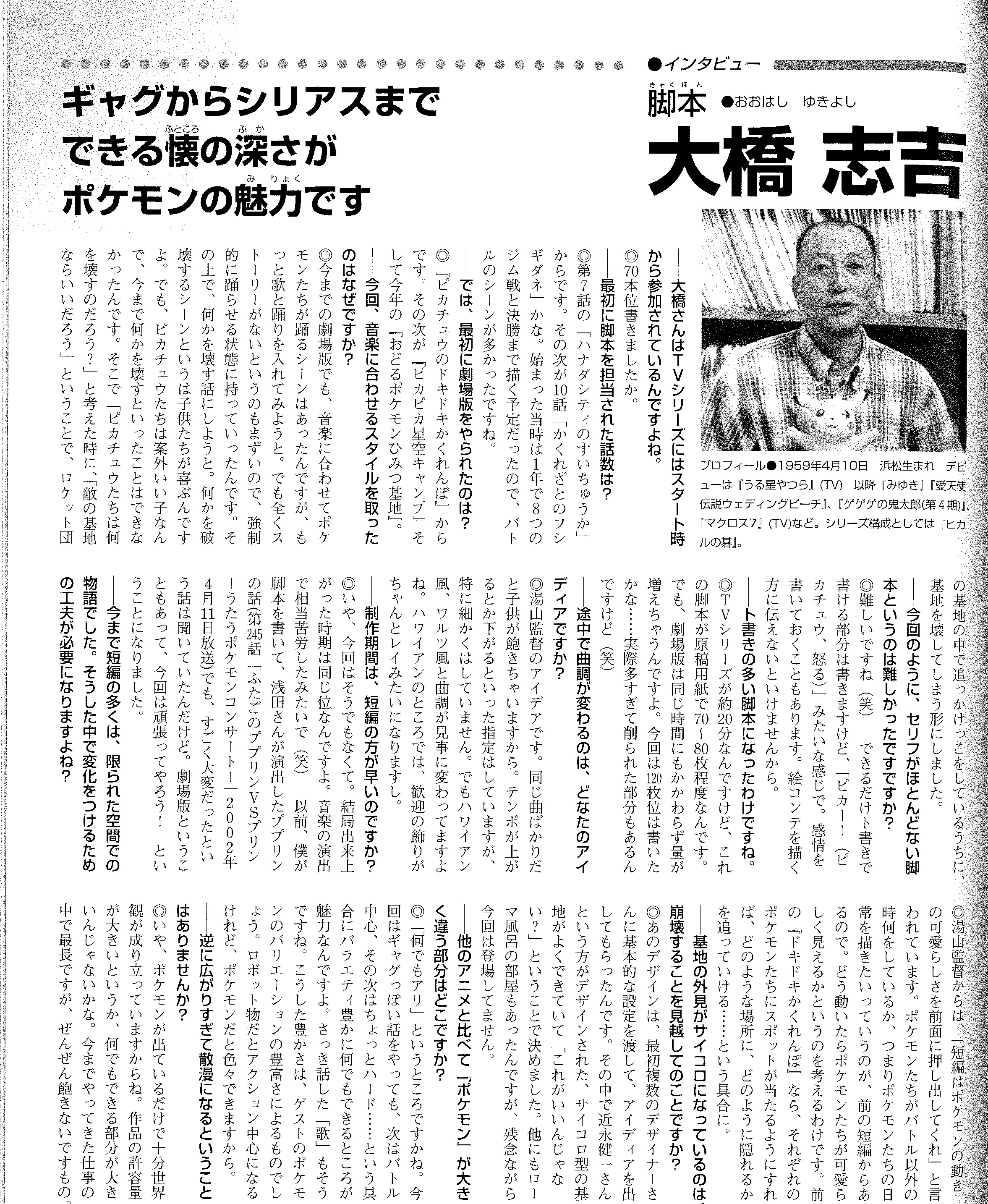Yukiyoshi Ohashi: Pokémon's open-mindedness, wherein it can go from gags to seriousness, is what makes it so appealing.

This Is Animation: The Wishing Star of Seven Nights — Jirachi
Profile: Born in Hamamatsu on April 10, 1959. His debut was "Urusei Yatsura" (TV). Since then, he has worked on "Miyuki," "Legend of the Angel of Love: Wedding Peach," "Gegege no Kitarou (4th season)," "Macross 7" (TV), etc. Worked as a series organizer on "Hikaru no Go."
—You have been involved in the TV series since its start.
I may have written about 70 shows.
—What were the first episodes you scripted?
I started with episode 7, "The Water Flowers of Hanada City." I think the next was episode 10, "Fushigidane of the Hidden Village." When it started, the plan was to depict 8 gym battles and the finals in one year, so there were a lot of battle scenes!
—So, when did you first work on the movies?
The first time was "Pikachu's Exciting Hide-and-seek." Next came "Glittering Starry Sky Camp" and this year's "Dancing Pokémon's Secret Base."
—Why did you choose the music style this time?
There have been scenes of Pokémon dancing to music in previous films, but I wanted to include more singing and dancing. But it would have been bad to have no story at all, so I forced them to dance. Then, we decided to make it a story about destroying something. Children love scenes in which something is destroyed. But Pikachu and company are nice guys, so we couldn't make them destroy anything. So when I thought about what Pikachu and friends would destroy, I thought, "An enemy base would be good," and I decided to make them destroy the base while they are in pursuit inside Team Rocket's base.
—Was it difficult to write a script like this one with almost no dialogue?
It was difficult (laughs). I try to write what I can in stage directions, like "Pika! (Pikachu is angry)." Sometimes I write down the emotions. Because I have to convey to the storyboard artist what they're feeling.
—So you end up with a script with a lot of notes.
The TV series is about 20 minutes long, and the script is about 70-80 pages. But for the movie version, even though it lasts the same amount of time, the script is much longer. I think I wrote about 120 pages this time... Actually, some parts were cut down because there were too many (laughs).
—Whose idea was it to change the melody as the story progresses?
It was Director Yuyama's idea. Because if we play the same song all the time, the children get bored. We specified that the tempo would go up or down, but not in any particular detail. But the melody changes beautifully from Hawaiian style to waltz style, doesn't it? In the Hawaiian part, the welcoming decorations look like leis and everything.
—Is the production time faster for shorts?
No, not really this time. In the end, the production time was about the same. It seems we had a lot of trouble with the music direction (laughs). I had heard that it was very difficult when I wrote the script for the Pupurin story (Episode 245 "Pupurin Twins VS Purin! Singing Pokémon Concert!" broadcast on April 11, 2002), which was directed by Asada. Since this was a film, we decided to do our best this time.
—Until now, most shorts have been told in a particular space. It is necessary to be creative to make a change in such a situation, isn't it?
Director Yuyama told me to push the cuteness of Pokémon's movements to the forefront in the shorts. Since the previous shorts, we wanted to depict what Pokémon do when they are not in battle, in other words, we wanted to depict the daily lives of Pokémon. We think about how to make Pokémon look cute. In the previous "Exciting Hide-and-seek," I wanted to spotlight each Pokémon so that the viewer can follow where and how they hide.
—Is the dicey appearance of the base in anticipation of its collapse?
I first gave the basic traits to several designers and asked them to come up with ideas for the design. Among them, Chikanaga Kenichi designed a dice-shaped base that was very well done, and we decided that this was the one we wanted. There was also another room with a Roman bath, but unfortunately it did not make an appearance this time.
—What is the main difference between Pokemon and other animations?
I would say that "anything goes." One episode may be a gag story, the next may focus on battles, and the next may be a bit hard-hitting, etc. The appeal of Pokemon is that it can do a wide variety of things. The same goes for the "songs" I mentioned earlier. This richness is due to the abundance of variations in the guest Pokémon. With robots, the focus is on action, but with Pokémon, you can do a lot of different things.
—On the other hand, is there any danger of it becoming too expansive and loose?
No, just having Pokémon show up is enough to keep a viable universe going. I think there is a large tolerance in the work, or rather, there is a lot of room for anything. This is the longest series I have ever worked on, but I never get tired of it.

